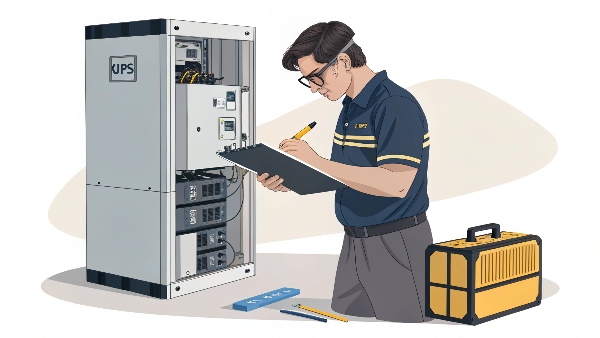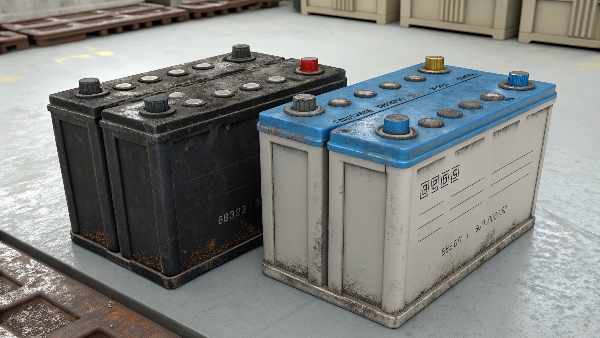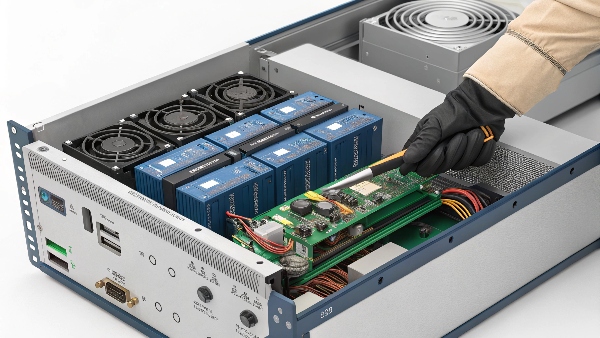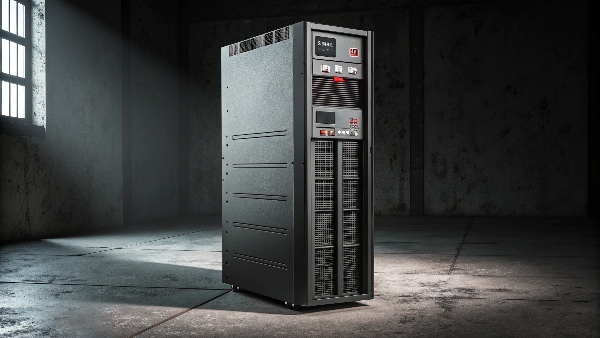Your critical systems suddenly go dark. The UPS, meant to protect them, has failed. This unexpected downtime causes chaos and potential data loss, a major concern for any operation.
Common causes for UPS shutdowns include battery failure, component aging like capacitors and fans, system overloads, and harsh environmental conditions. Regular maintenance and correctly sizing your UPS are crucial to prevent these unexpected power outages and ensure reliable protection.

As a long-time OEM/ODM manufacturer of UPS systems, we've seen firsthand how disruptive these failures can be for our clients, especially procurement managers and system integrators who rely on continuous power. Understanding why these shutdowns occur is the first step towards preventing them. Let's delve into the specifics.
What is the leading cause of UPS failure?
Your UPS unit unexpectedly fails, taking critical systems offline. Why does this keep happening despite your investment in power protection? This really shakes confidence, especially for system integrators.
The leading cause of UPS (Uninterruptible Power Supply) failure is overwhelmingly battery issues. Batteries are consumable components with a finite lifespan, typically 3-5 years for VRLA types, and their performance degrades over time, eventually leading to insufficient backup capacity when needed most.

Batteries are the heart of any UPS. When they can no longer hold an adequate charge, the UPS cannot perform its primary function during an outage.
We've helped countless clients, like Mr. Li from a hospital infrastructure company, select UPS systems with robust battery management.
The Finite Lifespan of UPS Batteries
All rechargeable batteries have a limited service life. For Valve Regulated Lead-Acid (VRLA) batteries, common in many UPS systems we design, this is typically 3 to 5 years under ideal conditions. Lithium-ion batteries, which we also offer as a high-efficiency solution, can last longer, perhaps 7-10 years or more, but they too will eventually degrade. This lifespan is not just a suggestion; it's a chemical reality. Over time, the battery's internal components wear out, reducing its ability to store and deliver power. Ignoring this leads directly to failure.
Factors Affecting Battery Health
Several factors can shorten a battery's life:
- Temperature: High ambient temperatures (above 25°C or 77°F) significantly accelerate aging. For every 8-10°C rise above this, battery life can be halved.
- Cycling: Frequent charge/discharge cycles, common in areas with unstable power, also wear batteries out faster.
- Storage: Improper storage of new batteries before installation can also impact their future performance.
- Charger Quality: The UPS's charging system plays a role. Overcharging or undercharging can damage batteries. Our designs always incorporate intelligent charging.
Importance of Proactive Battery Replacement
Waiting for a battery to fail is a risky strategy. We always advise our clients to implement a proactive battery replacement schedule based on the manufacturer's recommendations and environmental conditions. This is a key part of the value we provide as a trusted OEM/ODM supplier with CE, RoHS, and ISO certifications – ensuring long-term reliability.
| Battery Type | Typical Lifespan (Ideal Conditions) | Key Considerations |
|---|---|---|
| VRLA Lead-Acid | 3-5 Years | Cost-effective, sensitive to temperature |
| Lithium-Ion | 7-10+ Years | Higher upfront cost, longer life, lighter weight |
| Flooded Lead-Acid | 5-15 Years | Requires more maintenance, larger footprint |
Why does UPS shut down immediately?
The power flickers, and instead of providing backup, your UPS just dies. No warning, no grace period. This total failure completely defeats the purpose of having a UPS.
A UPS might shut down immediately due to a completely failed or disconnected battery, a severe internal fault like a blown inverter or faulty charger, a critical overload beyond its capacity, or an accidental activation of an Emergency Power Off (EPO) switch.

An immediate shutdown is a serious event. It's different from the UPS running on battery for a while and then shutting down gracefully. This indicates a more fundamental problem. As manufacturers, we design our UPS systems with safety mechanisms, but certain conditions can still cause this.
Critical Battery Failure or Disconnection
If the battery is completely dead, has a high internal resistance, or if its internal connections have failed, it cannot supply any power. Even if the UPS tries to switch to battery, there's nothing there. Sometimes, the battery might be physically disconnected due to a loose terminal, which is something we emphasize checking during installation for our ODM clients.
Severe Internal Component Catastrophe
A major internal fault can cause an immediate shutdown. This could be:
- Inverter Failure: The inverter converts DC battery power to AC power for your equipment. If it fails, the UPS cannot provide backup.
- Rectifier/Charger Failure: If the component responsible for charging the battery and passing mains power through fails catastrophically, it could shut the unit down.
- Control Board Malfunction: The brain of the UPS, if it fails, can lead to unpredictable behavior, including immediate shutdown.
Our comprehensive testing and certification processes (CE, RoHS, ISO) aim to minimize such component failures in the units we produce.
Overload or External Short Circuit
If the connected load suddenly draws far more power than the UPS is rated for (e.g., due to a faulty appliance or a short circuit downstream), the UPS's protective circuits will shut it down immediately to prevent damage to itself and potentially the load. Procurement managers should always ensure the UPS is correctly sized for the intended equipment.
Emergency Power Off (EPO) Activation
Many larger UPS systems, especially those for data centers or industrial use, have an EPO feature. If this switch is accidentally pressed or if the EPO circuit malfunctions, the UPS will shut down instantly. We always ensure clear documentation and training for this feature with our clients.
What is the common fault of UPS?
Your UPS is acting erratically again. These recurring problems are a headache, especially when you rely on it for critical systems. Understanding these frequent issues is key to quicker fixes.
Common UPS faults often stem from aging components. These include degraded batteries, worn-out capacitors and fans, loose internal or external connections, failing internal power supply units, and malfunctioning contactors or relays. Lack of regular maintenance exacerbates these issues.

Over our 10 years of experience manufacturing UPS systems, we've identified a consistent pattern of common faults. Addressing these proactively can significantly enhance reliability. Here are some key culprits based on the insights from many service calls:
Batteries: The Usual Suspect
As the heart of any UPS system, batteries require regular checkups. Their performance degrades over time. We always emphasize that routine testing and timely replacement are vital to ensure they remain fit to safeguard critical systems. This is the most common point of failure by far.
Capacitors: Aging and Drying Out
Electrolytic capacitors are crucial for filtering and smoothing power within the UPS. Over years of operation, especially in warmer environments, these capacitors can dry out, bulge, or leak. This degradation affects their ability to perform, leading to unstable output or even UPS failure. Our designs often specify high-temperature rated capacitors for longevity.
Filters: Keeping Power Clean
Input and output filters protect the UPS and the load from electrical noise. These filters can sometimes degrade or, in rare cases, fail due to extreme power events. Their failure can lead to poor power quality or a non-functional UPS.
Connections: The Overlooked Point of Failure
Loose or corroded connections, both internal (e.g., battery terminals, PCB connectors) and external (input/output plugs), can cause intermittent problems, overheating, or complete failure. Regular visual inspections and ensuring tight connections are simple but effective preventative measures. We often see this in environments with high vibration or temperature cycling.
Internal Power Supplies: Powering the Protector
The UPS itself has small internal power supplies that power its control logic and display. If these auxiliary power supplies fail, the entire UPS can become unresponsive.
Contactors and Relays: The Switching Gear
These electromechanical components are responsible for switching between mains and battery power, or bypassing the UPS. Over time, their contacts can wear out, stick, or become resistive, leading to operational failures.
Fans: Essential for Cooling
Fans are critical for dissipating heat generated by UPS components. If a fan fails or its airflow is blocked by dust, components can overheat. This overheating can lead to premature failure of other parts, like capacitors, or even an immediate thermal shutdown of the UPS. Regular cleaning and fan replacement are part of good maintenance.
| Common Fault | Typical Symptom | Our OEM/ODM Focus for Prevention |
|---|---|---|
| Degraded Battery | Short runtime, fails during outage | Quality battery sourcing, advanced battery management systems |
| Bad Capacitors | Unstable output, alarm, UPS won't turn on | High-quality, long-life capacitors, thermal design |
| Clogged Filters | Overheating, reduced efficiency | Accessible filter design for easy cleaning/replacement |
| Loose Connections | Intermittent operation, sparks, overheating | Robust connectors, clear torque specifications for terminals |
| Failed PSU | UPS dead, no lights | Redundant or high-reliability internal power supply designs |
| Worn Contactors | Fails to switch to battery, chattering sound | Use of durable, appropriately rated contactors and relays |
| Failed Fan | Overheat alarm, UPS shutdown | Quality fans, fan speed control, monitoring of fan status |
Why is my UPS suddenly not working?
Your previously reliable UPS is suddenly dead. No lights, no power output – nothing. This abrupt failure can halt critical operations, creating an urgent situation for system integrators and their clients.
A UPS might suddenly stop working due to a tripped input circuit breaker, a complete and catastrophic battery failure, a major internal component meltdown, an external short circuit on its output, or severely incorrect input power (e.g., wrong voltage).

When a UPS that was functioning fine suddenly gives up, it's alarming. As an OEM/ODM partner, we help clients troubleshoot these scenarios to restore power quickly. The cause can range from something simple to a more serious internal issue.
Checking Basic Power Input and Breakers
The first thing to check is the input power.
- Is the UPS properly plugged in? It sounds basic, but it happens.
- Has the input circuit breaker for the UPS (in your building's electrical panel) tripped? An overload or a fault elsewhere could cause this.
- Does the UPS itself have an input circuit breaker or fuse? Many models do, and it might have tripped. Resetting this (after ensuring no overload) can sometimes resolve the issue. This is a common first check for procurement managers troubleshooting a site.
Catastrophic Battery Failure
While battery degradation usually leads to reduced runtime, a sudden internal short or complete disconnection within the battery pack can cause the UPS to fail to power on or shut down abruptly. This is less common than gradual failure but can occur, especially with older or poorly maintained batteries. Our lithium battery UPS solutions often have more sophisticated battery management systems to prevent such abrupt issues.
Major Internal Component Failure
A critical component inside the UPS, such as the main power supply, inverter, or control board, could have failed catastrophically. This might be due to a power surge that overwhelmed its protection, component aging, or a manufacturing defect (though our rigorous CE, RoHS, and ISO certified quality assurance minimizes this). This usually requires professional repair or replacement of the unit.
External Load Issues Creating a Short Circuit
If a device connected to the UPS output develops a severe short circuit, the UPS will likely shut down to protect itself. Unplugging all connected devices and then trying to power on the UPS can help diagnose this. If the UPS powers on without a load, one of the connected devices is the culprit. We advise clients to test this methodically.
Incorrect Input Voltage or Severe Power Disturbance
If the input voltage to the UPS is drastically wrong (e.g., connecting a 120V UPS to a 220V supply, or vice-versa) or if there's a very severe and sustained power event, the UPS might shut down to protect itself, or it could be damaged. Our patented technology development often includes wider input voltage tolerance to handle such situations better in specific regions.
Conclusion
Understanding common UPS failure causes, from battery degradation to component wear, empowers proactive maintenance. This knowledge helps prevent unexpected shutdowns, ensuring reliable power and protecting your critical systems effectively.

